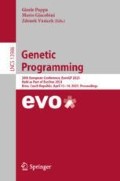Abstract
In many evolutionary computation systems, parent selection methods can affect, among other things, convergence to a solution. In this paper, we present a study comparing the role of two commonly used parent selection methods in evolving machine learning pipelines in an automated machine learning system called Tree-based Pipeline Optimization Tool (TPOT). Specifically, we demonstrate, using experiments on multiple datasets, that lexicase selection leads to significantly faster convergence as compared to NSGA-II in TPOT. We also compare the exploration of parts of the search space by these selection methods using a trie data structure that contains information about the pipelines explored in a particular run.
Access this chapter
Tax calculation will be finalised at checkout
Purchases are for personal use only
Notes
- 1.
Individual \(i_1\) dominates \(i_2\) if \(i_1\) is better than or the same as \(i_2\) on all objectives and strictly better than \(i_2\) on at least one objective.
- 2.
https://github.com/EpistasisLab/exploration-trie-tpot including code and supplementary material.
References
Burlacu, B., Affenzeller, M., Kommenda, M., Winkler, S., Kronberger, G.: Visualization of genetic lineages and inheritance information in genetic programming. In: Proceedings of the 15th Annual Conference Companion on Genetic and Evolutionary Computation, pp. 1351–1358 (2013)
Ciesielski, V., Mawhinney, D.: Prevention of early convergence in genetic programming by replacement of similar programs. In: Proceedings of the 2002 Congress on Evolutionary Computation, CEC 2002 (Cat. No. 02TH8600), vol. 1, pp. 67–72. IEEE (2002)
Deb, K., Pratap, A., Agarwal, S., Meyarivan, T.: A fast and elitist multiobjective genetic algorithm: NSGA-II. IEEE Trans. Evol. Comput. 6(2), 182–197 (2002)
Deb, K., Thiele, L., Laumanns, M., Zitzler, E.: Scalable test problems for evolutionary multiobjective optimization. In: Abraham, A., Jain, L., Goldberg, R. (eds.) Evolutionary Multiobjective Optimization. Advanced Information and Knowledge Processing, pp. 105–145. Springer, London (2005). https://doi.org/10.1007/1-84628-137-7_6
Dietterich, T.: Approximate statistical tests for comparing supervised classification learning algorithms. Neural Comput. 10, 1895–1923 (1998)
Fortin, F.A., De Rainville, F.M., Gardner, M.A., Parizeau, M., Gagné, C.: DEAP: evolutionary algorithms made easy. J. Mach. Learn. Res. 13, 2171–2175 (2012)
Helmuth, T., Spector, L., Matheson, J.: Solving uncompromising problems with lexicase selection. IEEE Trans. Evol. Comput. 19(5), 630–643 (2014)
La Cava, W., Moore, J.H.: An analysis of \(\epsilon \)-lexicase selection for large-scale many- objective optimization. In: Proceedings of the Genetic and Evolutionary Computation Conference Companion, pp. 185–186 (2018)
La Cava, W., Spector, L., Danai, K.: Epsilon-lexicase selection for regression. In: Proceedings of the Genetic and Evolutionary Computation Conference 2016, pp. 741–748 (2016)
Langdon, W.B.: Genetic programming convergence. Genet. Program Evolvable Mach. 23(1), 71–104 (2022)
Latora, V., Marchiori, M.: Efficient behavior of small-world networks. Phys. Rev. Lett. 87, 198701 (2001). https://doi.org/10.1103/PhysRevLett.87.198701, https://link.aps.org/doi/10.1103/PhysRevLett.87.198701
McPhee, N.F., Finzel, M.D., Casale, M.M., Helmuth, T., Spector, L.: A detailed analysis of a PushGP run. In: Riolo, R., Worzel, B., Goldman, B., Tozier, B. (eds.) Genetic Programming Theory and Practice XIV. GEC, pp. 65–83. Springer, Cham (2018). https://doi.org/10.1007/978-3-319-97088-2_5
Metevier, B., Saini, A.K., Spector, L.: Lexicase selection beyond genetic programming. In: Banzhaf, W., Spector, L., Sheneman, L. (eds.) Genetic Programming Theory and Practice XVI. GEC, pp. 123–136. Springer, Cham (2019). https://doi.org/10.1007/978-3-030-04735-1_7
Moore, J.M., McKinley, P.K.: A comparison of multiobjective algorithms in evolving quadrupedal gaits. In: Tuci, E., Giagkos, A., Wilson, M., Hallam, J. (eds.) SAB 2016. LNCS (LNAI), vol. 9825, pp. 157–169. Springer, Cham (2016). https://doi.org/10.1007/978-3-319-43488-9_15
Oh, H., et al.: Convergence-aware neural network training. In: 2020 57th ACM/IEEE Design Automation Conference (DAC), pp. 1–6. IEEE (2020)
Olson, R.S., Urbanowicz, R.J., Andrews, P.C., Lavender, N.A., Kidd, L.C., Moore, J.H.: Automating biomedical data science through tree-based pipeline optimization. In: Squillero, G., Burelli, P. (eds.) EvoApplications 2016. LNCS, vol. 9597, pp. 123–137. Springer, Cham (2016). https://doi.org/10.1007/978-3-319-31204-0_9
Orlenko, A., et al.: Model selection for metabolomics: predicting diagnosis of coronary artery disease using automated machine learning. Bioinformatics 36(6), 1772–1778 (2020)
Orzechowski, P., Moore, J.H.: Generative and reproducible benchmarks for comprehensive evaluation of machine learning classifiers. Sci. Adv. 8(47), eabl4747 (2022). https://doi.org/10.1126/sciadv.abl4747, https://www.science.org/doi/abs/10.1126/sciadv.abl4747
Saini, A.K., Spector, L.: Relationships between parent selection methods, looping constructs, and success rate in genetic programming. Genet. Program Evolvable Mach. 22(4), 495–509 (2021)
Snedecor, G.W., Cochran, W.G.: Statistical Methods, 8th edn. Iowa State University Press (1989)
Acknowledgements
This work is supported by National Institute of Health grants R01 LM010098 and R01 AG066833.
Author information
Authors and Affiliations
Corresponding authors
Editor information
Editors and Affiliations
Rights and permissions
Copyright information
© 2023 The Author(s), under exclusive license to Springer Nature Switzerland AG
About this paper
Cite this paper
Matsumoto, N. et al. (2023). Faster Convergence with Lexicase Selection in Tree-Based Automated Machine Learning. In: Pappa, G., Giacobini, M., Vasicek, Z. (eds) Genetic Programming. EuroGP 2023. Lecture Notes in Computer Science, vol 13986. Springer, Cham. https://doi.org/10.1007/978-3-031-29573-7_11
Download citation
DOI: https://doi.org/10.1007/978-3-031-29573-7_11
Published:
Publisher Name: Springer, Cham
Print ISBN: 978-3-031-29572-0
Online ISBN: 978-3-031-29573-7
eBook Packages: Computer ScienceComputer Science (R0)

